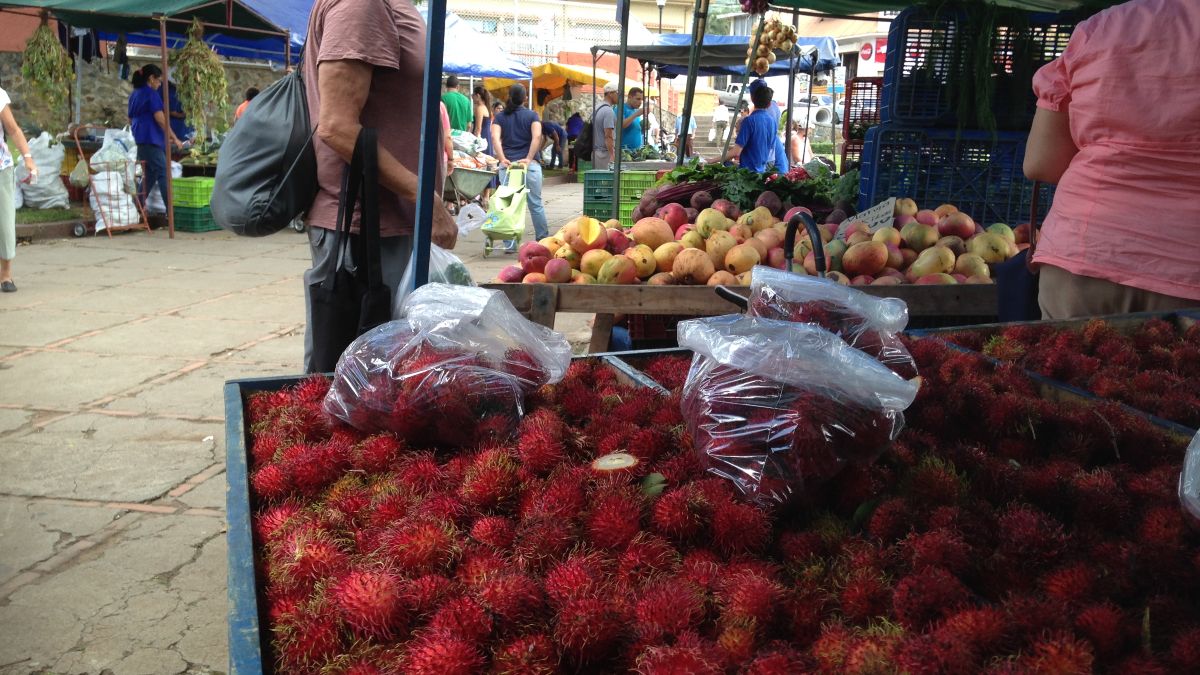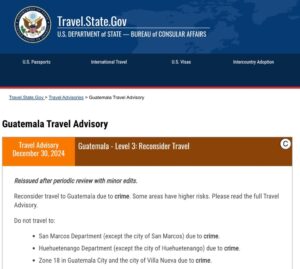Central American Fruit and Vegetables
6 min readHighlighting some of our favorite Central American fruit and vegetables like creamy mameys, tart tomatillos, dragon fruit, and more.
The post Our Favorite Central American Fruit and Vegetables appeared first on Central America.

While bananas and pineapples are well-known tropical fruits, Central America has a wealth of unique native produce worth exploring. This article highlights some of our favorite Central American fruit and vegetables like creamy mameys, tart tomatillos, dragon fruit, and more.
Happy National Eat More Fruits and Vegetables Day folks! Every May 21st, apparently, this day is all about emphasizing how important it is that we should eat more fruits and vegetables than we do. The fact that it was the Dole Fruit Company of all things that came up with this day for, we’re sure, purely altruistic reasons, shouldn’t really deter us from the message.
While we all love a nice fresh apple, a juicy orange, or a delicious banana, here in Central America we can get a bit more exotic that that. Sure, bananas are everywhere – even in my garden – and oranges and apples are easy to get, both in farmers’ markets and supermarkets. The only fruit that is often hard to find in the region are lemons – real yellow lemons, I mean. Limes are everywhere and they’re delicious and also – confusingly – called lemons. But I digress. This article is about highlighting some of the our favorite native Central American fruit and vegetables.
What Does “Native” Mean?
By native we mean this: fruits and veggies that originated in the region. While bananas and pineapples make up a large part of the economy (here is where the term “Banana Republic” came from), neither is actually Central American. Bananas come from SE Asia and pineapples from South America. It’s possible we’re being churlish about pineapples, as the Aztecs and Mayans were cultivating them early. So be it. Same thing with coconuts. While it’s impossible to imagine a Central American beach without swaying coconut palms, they actually came to the Americas with European colonists. So the list below will be fruits and vegetables that are native to the region only. They’re all delicious, all easy to find, and all worth shouting out on this Eat More Fruits and Vegetables Day. Let’s dive in:
Our Favorite Native Central American Fruit and Vegetables
Jocote
This small, plum-like fruit has thin reddish or purple skin and juicy yellow-orange flesh with a slightly tart, sweet flavor. The flesh is often used to make beverages, jellies, or preserves. Jocotes grow on trees native to Mexico and Central America.
Mamey
A large, round or oval tropical fruit with rough brown skin, mameys contain rich, creamy salmon-colored flesh with a sweet flavor reminiscent of sweet potatoes and pumpkins. The dense, velvety flesh can be eaten fresh, used in milkshakes, ice creams, and other desserts.
Nance
Resembling a small yellow cherry, this fruit has a thin skin and juicy, slightly acidic yellow flesh that is commonly used to make beverages, jams, or preserves. Nance is rich in vitamins A and C and native to Mexico and Central America.
Chayote
Pear-shaped with light green ridged grooves, chayotes have a crisp, mild white flesh similar in texture and flavor to cucumbers. A very versatile vegetable that can be sautéed, baked, stuffed or cooked in various other ways in Central American cuisine. Excellent in soups.
Guava
Round or oval with yellow-green skin, guavas contain white or red juicy flesh with numerous edible seeds. They have a distinct sweet yet slightly tart taste and are used for juices, jams, and desserts across the region.
Tomatillo
Enclosed in a papery husk, tomatillos are small green fruits with a tart, slightly acidic flavor widely used in authentic Mexican and Central American green sauces, stews, and salsas like salsa verde.
Sapodilla
This oval brown fruit has rough skin and a sweet, pudding-like brown flesh with a texture similar to a very ripe pear. The unique flavor makes sapodillas popular for eating fresh or using in milkshakes and desserts.
Pitahaya (Dragon Fruit)
With its bright red outer skin covered in green scales, dragon fruit has a striking interior of either crisp white or vivid red flesh dotted with small edible black seeds. It has a subtly sweet and slightly tangy tropical flavor.
Chiltepe
These are small, thin green or red chili peppers tapering to a point. Chiltepes pack an intense, fruity punch of spicy heat when used in traditional Central American cuisine and dishes.
Loroco
The edible green flowering buds and blossoms of this vine vegetable lend a unique, slightly bitter flavor to classic Salvadoran dishes like pupusas and stews when used as an herb.
Papaya
Native to southern Mexico and Central America, papayas are large, oblong fruits with yellow-orange flesh and black seeds in a hollow center. They have a sweet, musky flavor and buttery texture when ripe, and are rich in vitamins A and C.
Tamarind
Long, brown pod-like fruits that contain sticky, tangy-sweet brown pulp and hard-coated seeds. The unique, tart-yet-sweet pulp balances both flavors and is used in many authentic Central American dishes, marinades, and beverages.
Cashew Apple
While the cashew nut is well-known, the cashew apple is the fleshy, red/yellow stem to which the cashew is attached, shaped like a small bell pepper. It has a sweet, slightly tart taste and is used to make juices, jams, and fermented drinks.
Cacao
The source of chocolate, these oval-shaped pods with tough, ridged red or yellow-orange rinds grow on trees native to Central America. Inside are cocoa beans surrounded by sweet, pulpy white flesh that can be eaten fresh or used for beverages.
Jicama
A large, round root vegetable with tan skin and crisp, juicy white flesh. Jicamas have a sweet, incredibly refreshing flavor reminiscent of apples or pears. They are often enjoyed raw in salads or as a snack with lime and chili.
Rambutan (Mamón Chino)
An oval tropical fruit with a bright reddish outer skin covered in soft, hairlike spines or protrusions. Beneath is sweet, translucent white flesh with a refreshing, slightly acidic grape-like flavor surrounding an inedible seed.
You might have noticed that all the above are actually fruits and not vegetables. We admit that surprised us, too. There are tons of vegetables you might think are from Central America, like squashes or sweet potatoes. Although this leads us to the question of what is the difference between a fruit and veritable anyway? Because squashes are technically fruit, apparently. And many typical veggies like yuca, which I always thought was from Central America, actually is not. So we’re stuck with the list above, and we still think it’s a good one.
Eat More Fruit and Vegetables!
So there you have it – some of our fave and most unique fruits and veggies (well, fruits) native to this part of the world. From the creamy indulgence of a ripe mamey to the refreshing pop of a rambutan, it’s a culinary experience that can only be had here in Central America.
While the banana may be the iconic tropical fruit, we’ve got plenty more where that came from. Bright dragon fruits that look like they were plucked from a psychedelic garden. Tart little tomatillos waiting to be transformed into a zesty salsa. The humble but versatile chayote, an unsung hero of Central American cuisine.
Not to mention all those fruits you may have never heard of before – jocotes, nances, sapodillas. Each one a flavor revelation waiting to happen. And let’s not forget the fiery chiltepes and lorocos adding their signature kick to countless traditional dishes.
So next time you’re wandering through a feria, don’t just grab a banana and be done with it. Branch out, get adventurous, and celebrate this Eat More Fruits and Veggies Day by, well, eating some Central American fruit and veggies. Your taste buds will thank you.
James Dyde is the editor of centralamerica.com. He lives in Escazu, Costa Rica.
Discover more from Slow Travel News
Subscribe to get the latest posts sent to your email.



